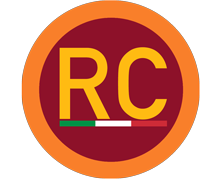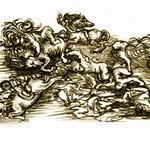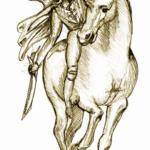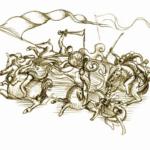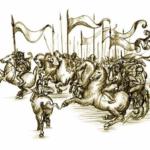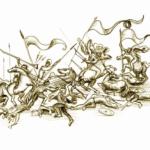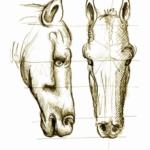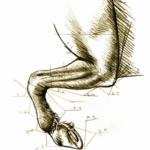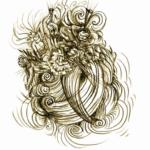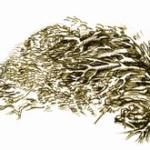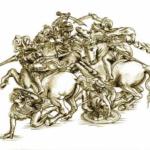 Every year on 29th June, the day of the anniversary of the Battle, Anghiari celebrates the event with a solemn feast: the Palio della Vittoria, a foot race in costume along the road of Anghiari that in 1440 was the famous battle between the Florentines and Milanesi, immortalized by Leonardo da Vinci in a mysteriously lost painting.
Every year on 29th June, the day of the anniversary of the Battle, Anghiari celebrates the event with a solemn feast: the Palio della Vittoria, a foot race in costume along the road of Anghiari that in 1440 was the famous battle between the Florentines and Milanesi, immortalized by Leonardo da Vinci in a mysteriously lost painting.
Also this year on 29 June 2018 in the town of Anghiari, in the province of Arezzo, the Palio della Vittoria will take place to celebrate the Battle of Anghiari fought in 1440 and also known for the 1505 fresco by Leonardo Da Vinci it is lost track.
 The 16th edition of the modern era opens on Friday 29 June 2018 at 18:30 with the historical re-enactment and with the arrival, in Piazza Baldaccio, of the Mayors and historical groups of the participating municipalities and will live the most expected at sunset with the start of the uphill race (1440 meters from the Chapel of Victory located in the plain that binds Anghiari and Sansepolcro up to Piazza Baldaccio) and that will award the winning municipality the palio.
The 16th edition of the modern era opens on Friday 29 June 2018 at 18:30 with the historical re-enactment and with the arrival, in Piazza Baldaccio, of the Mayors and historical groups of the participating municipalities and will live the most expected at sunset with the start of the uphill race (1440 meters from the Chapel of Victory located in the plain that binds Anghiari and Sansepolcro up to Piazza Baldaccio) and that will award the winning municipality the palio.
The video below shows the edition of last year during which the city of Florence was awarded the title with Ivan Poggi.
The re-enactment sees the presence of the historical groups of the Municipalities of Florence, Arezzo, Sansepolcro, Anghiari and this year for the first time of the Scannagallo Cultural Association, while the race will be broadcast live on the web, in the big screen located in Piazza Baldaccio and on Teletruria (http://teletruria.it/diretta-tv).
Each municipality can present at the start of the race a maximum of 7 athletes.
Many side events that will start from Sunday, June 24, 2018, day in which they are scheduled the “Second National Tournament LAM Archers” in the historic center of Anghiari (from 8:30 to 16:00) and the “Blessing of the Palio” (from 8.30 pm).
Back in time up to 400 d.c.
 Anghiari (in the province of Arezzo) is one of the oldest Palio in Italy and in all of Tuscany, it has its roots in 1441 and has celebrated the region and its cultural identity for four centuries. The Victory of Anghiari occurred in 1440, when the boundaries of the Duchy of Tuscany were definitively established after the Battle. The town of Anghiari retraces this traditional feast, even if originally this Palio, which was run at the same time as Anghiari and Florence.
Anghiari (in the province of Arezzo) is one of the oldest Palio in Italy and in all of Tuscany, it has its roots in 1441 and has celebrated the region and its cultural identity for four centuries. The Victory of Anghiari occurred in 1440, when the boundaries of the Duchy of Tuscany were definitively established after the Battle. The town of Anghiari retraces this traditional feast, even if originally this Palio, which was run at the same time as Anghiari and Florence.
 So every year on 29 June, at sunset, every town of Valtiberina in Tuscany will line up its competitors and begin a 1400 meter walking race that starts from the Cappella della Vittoria and reaches Piazza Baldaccio, which is the heart of the medieval city of Anghiari.
So every year on 29 June, at sunset, every town of Valtiberina in Tuscany will line up its competitors and begin a 1400 meter walking race that starts from the Cappella della Vittoria and reaches Piazza Baldaccio, which is the heart of the medieval city of Anghiari.
Competitors are thrown on the path having to resist the charges of the opponents, who try to push it into the ditches so as not to get it to the finish line first.
The Palio is the prize, which will honor the winning municipality.
Very beautiful and not to be missed is also the historical procession that precedes the race, with parades in medieval clothes, the Sbandieratori di Sansepolcro, the Musicians of the Giostra del Saracino of Arezzo.
THE LOST PAINTING, MYSTERY OF LEONARDO
In 1503 Leonardo da Vinci and Michelangelo Buonarroti found themselves having to confront themselves directly, receiving both, from the Florence gonfalonier Pier Soderini, the task of frescoing two large adjacent walls inside the hall of the municipal council of Palazzo Vecchio. Both artists were commissioned to paint two great Florentine victories with paintings 7 meters high and 17 wide. Leonardo was commissioned to paint the Battle of Anghiari and Michelangelo that of Càscina.
 Michelangelo only made the cardboard of the Battle of Cascina that almost immediately went missing and of which only one copy left today is made by his disciple Aristotle da Sangallo.
Michelangelo only made the cardboard of the Battle of Cascina that almost immediately went missing and of which only one copy left today is made by his disciple Aristotle da Sangallo.
Also the work of Leonardo da Vinci has been lost and remains the testimony through the works of Rubens and Biagio di Antonio of the school of Paolo Uccello.
The Battle of Anghiari is ironically described by Machiavelli, who wrote: “And in such a broken course and in so long a fight that lasted from twenty to twenty-four hours, there died that a man, who is not wounded or of another virtuous blow, but he fell from his horse and trampled “
IL MISTERO DEL DIPINTO
 Many believe that the Battle of Anghiari by Leonardo Da Vinci is a composition in which we see a group of soldiers fighting for possession of a flag with two large horses in the foreground. The most famous design of the Battle of Anghiari is that of Rubens, built in 1603.
Many believe that the Battle of Anghiari by Leonardo Da Vinci is a composition in which we see a group of soldiers fighting for possession of a flag with two large horses in the foreground. The most famous design of the Battle of Anghiari is that of Rubens, built in 1603.
Some even confuse this design with the work of Leonardo. Rubens’ copy is a reality behind the original 100-year-old Leonardo, so it is possible that the Battle of Rubens is in turn a copy of a copy probably of a part of Leonardo’s original painting.
 Some think that Tavola Doria, created by an anonymous man between 1503/1505, is to be attributed to Leonardo as part of the fresco of the Battle of Anghiari. The painting presents itself with less details, raw and unfinished and, according to historians, is more important than that of Rubens because of its close date to the original. The author is unknown but the criticism is divided between those who consider it the work of the same Leonardo and who considers it a copy of an anonymous Florentine of the sixteenth century as in the drafts of Leonardo for the battagla of Anghiari, do not appear daggers, knives or municipalities small white weapons, but only long spears. Moreover, many critics point out that the style and the “sign” do not seem to be that of Leonardo.
Some think that Tavola Doria, created by an anonymous man between 1503/1505, is to be attributed to Leonardo as part of the fresco of the Battle of Anghiari. The painting presents itself with less details, raw and unfinished and, according to historians, is more important than that of Rubens because of its close date to the original. The author is unknown but the criticism is divided between those who consider it the work of the same Leonardo and who considers it a copy of an anonymous Florentine of the sixteenth century as in the drafts of Leonardo for the battagla of Anghiari, do not appear daggers, knives or municipalities small white weapons, but only long spears. Moreover, many critics point out that the style and the “sign” do not seem to be that of Leonardo.
Among the many existing copies, perhaps the only interesting is the work of Andrea Commodi who has made a different design of the battle compared to that of Rubens, with additions of other horses and riders and this suggests that in the original may have been many other subjects painted around the group designed by Rubens.
LEONARDO’S INDICATION
 In the Madrid II manuscript, on page 1r, there is the only clue directly written by Leonardo in clear relation with the painting of the Battle of Anghiari. In a few lines written in the middle of the page Leonardo tells us that the day 6 June 1505 began to color.
In the Madrid II manuscript, on page 1r, there is the only clue directly written by Leonardo in clear relation with the painting of the Battle of Anghiari. In a few lines written in the middle of the page Leonardo tells us that the day 6 June 1505 began to color.
At the center of the page we read:
” Addì 6 di giugno 1505 in venerdì, al tocco delle 13 ore, cominciai a colorire in palazo. Nel qual punto del posare il pennello, si guastò il tempo e sonò a banco, richiedendo li omini a ragione. Il cartone si stracciò, l’acqua si versò, e ruppesi il vaso dell’acqua che si portava. E subito si guastò il tempo e piovve in siano a sera acqua grandissima.E stette il tempo come notte.”
TRAD: “On the 6th of June 1505 on Friday, at 13 o’clock, I began to color in palazo, where the brush was laid, the weather was spoiled and I played at the desk, promptly asking for it. the water poured out, and the vessel of the water that was brought up was ruptured, and immediately the weather was spoiled and it rained in the evening in great water. And the weather stayed like night. “
LEONARDO’S SCHIZZI AND RECONSTRUCTION
Recovering all the drawings that Leonardo created for artistic design regarding a generic battle together with those that are certainly related to that of Anghiari, it was possible to reconstruct the preparation plan of the lost painting. All the sketches of Leonardo have been redesigned and through the historical documents and the legends about the Battle it was decided to insert some episodes in the composition.

Two compositions were made from Leonardo’s sketches: one with proportions of 20 x 8 meters, the other of 16 x 8 meters. The first, more extensive, fits perfectly with the size of the wall that was made available to Leonardo. The second one is shorter so that it can be better adapted to the architecture of the hall.
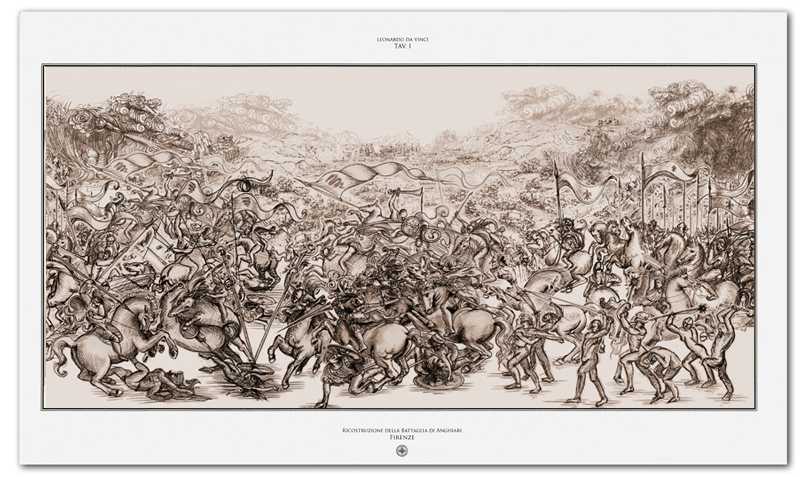
The composition was made using all the soldiers and knights derived from Leonardo’s drawings and in the foreground appears the group copied by Rubens.
THE ANCIENT PALIO OF ANGHIARI
 Nearby Arezzo, Sansepolcro and Città di Castello, Anghiari is considered one of the most beautiful villages in Italy. Worthy of note are the historic Palazzo Taglieschi, the Church of Sant’Agostino and the Museum of the Battle of Anghiari.
Nearby Arezzo, Sansepolcro and Città di Castello, Anghiari is considered one of the most beautiful villages in Italy. Worthy of note are the historic Palazzo Taglieschi, the Church of Sant’Agostino and the Museum of the Battle of Anghiari.
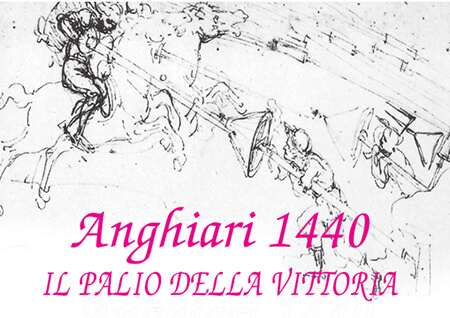 It was in 1827 that the last edition of the Palio della Vittoria was held at Anghiari. Because of the umpteenth brawl, which cost the life of a jockey, the Palio was finally suppressed. Anghiari, with that Palio, had for four centuries celebrated Tuscany and its cultural identity: on June 29, 1440, as is well known, with the famous and victorious Battaglia the boundaries of the Duchy of Tuscany were definitively established.
It was in 1827 that the last edition of the Palio della Vittoria was held at Anghiari. Because of the umpteenth brawl, which cost the life of a jockey, the Palio was finally suppressed. Anghiari, with that Palio, had for four centuries celebrated Tuscany and its cultural identity: on June 29, 1440, as is well known, with the famous and victorious Battaglia the boundaries of the Duchy of Tuscany were definitively established.
After sporadic and uncertain shooting of the race (between the end of the nineteenth and the middle of the twentieth century), the Palio della Vittoria is back with all its deep significance. To celebrate the Battle of Anghiari, it was also held in Florence at the same time, from Corso de ‘Tintori to the Arco di Sanpierino. In Pisa there was an exceptional Game of the Bridge. And Leonardo da Vinci, painting it in the Salone dei Cinquecento, made it a myth for painters throughout the Renaissance.
At the sunset of every 29 June, after the announcement of the Challenge, the procession, opened by the Mayor and the Gonfalone of Anghiari, will head to the Chapel of Victory where, at 20, the shot of the bomb will kick off the epic challenge among the runners , representatives not themselves but their Municipalities.
Associazione Palio della Vittoria
Tel. +39 0575 749279
www.valtiberinaintoscana.it/eventi/anghiari/palio-della-vittoria-2018
How to arrive
Highway A1 up to Arezzo, SS73 for 30 km or S.P. 43 Libya. From Perugia, Assisi and Cesena take the E 45, Sansepolcro exit. From Rimini and San Marino follow the S.S. 258 “Marecchiese”.
Informations
Museo della Battaglia e di Anghiari +39 0575 787023
Pro Loco Anghiari +39 0575 749279
www.facebook.com/Palio-della-Vittoria-1547935478781381/
[codepeople-post-map]
The Rome Central – Italy in the world editorial staff consists of freelance editors, journalists, photographers, filmmakers, doctors, writers, video-makers, supporters, poets, writers, actors, singers and many friends.
RomeCentral is a Magazine completely no-profit , whoever writes in this magazine does his job without any commercial pressure.
NB: No people in Rome Central, from managers to employees etc .., receive any type of compensation.
The love for the free journalism repays all our efforts.
